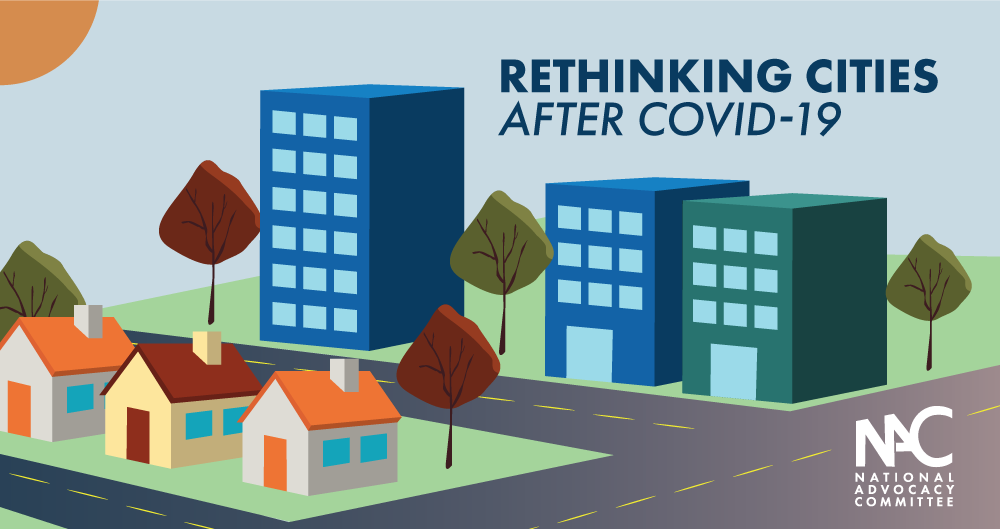Rethinking Cities After COVID-19
Celebrating NAHREP familia, cultura, politics, and grassroots action
February 4, 2021
Qué onda mi gente?!
Aside from my work in the policy and advocacy space, I run the Hispanic Wealth Project along with HWP Chairman Jerry Ascencio. One of my favorite things about the NAHREP 10 is that no matter where we are in our financial journey, whether we just got our real estate license and are working on paying off our credit cards or we’re extremely successful business owners, there is always a place to improve. For me, I’ve been focusing on tackling NAHREP 10 Discipline #5: Invest at least 20% of your income in real estate and stocks, because they are the best and safest way to build wealth.
Since I have paid off all my debt and my husband and I purchased our first home last year, I’m actively working on becoming a savvy investor. I have a brokerage account, I read up on what Warren Buffett is buying, and I follow Reddit investing forums. I also look to public policy decisions to determine what makes sense to buy. YES, investing has SO MUCH to do with what happens in the news and in government. We need to actively have these conversations among ourselves so that we can regularly learn from one another on our road to building intergenerational wealth. We have each other, let’s lean in!
The second aspect of NAHREP 10 Discipline #5 is investing in real estate. As professionals in the industry, many of us feel the most comfortable investing in this space. But what happens when the supply doesn’t meet demand? As you know, low housing supply is perhaps one of the most critical policy areas for NAHREP as it is the single greatest barrier to advancing sustainable Hispanic homeownership. But today, in part due to the pandemic, we are seeing a different supply and demand issue in some communities: an oversupply of commercial real estate space.

NAHREP is supporting legislation to allow residential development on commercially zoned land
The pandemic has created a game changer that we must take advantage of. The high percentage of people working from home and the increase in online shopping is bound to be one of the longest lasting elements of the pandemic. Some places have already been seeing high vacancy rates for retail spaces and office buildings for years, long before the pandemic. Empty store fronts and office buildings that can be rezoned for residential or mixed-use space could help to solve our housing crisis today.
Case Study: Converting California’s commercial spaces
According to research conducted by the UC Berkley Terner Center, every major metro within the state of California has an abundance of commercially zoned property. The majority of commercial zones identified by the Terner Center are located in suburban areas, places that have historically been resistant to higher density and infill development. The total amount of commercial space is quite staggering:
- Greater Los Angeles: 191,000 acres – this is more than twice the size of Bakersfield!
- Bay Area: 57,000 acres
- San Diego: 20,000 acres
- Sacramento: 29,000 acres
The report points out that most of the space (66 percent) is retail while the rest is a mix of office buildings or even vacant land. With the rise of online shopping, “big box” and other retail stores have been hit hard for years. The pandemic has only amplified this trend. Now, you might say, “but I love my neighborhood shops! I don’t want to see them go.” We do too! However, it’s important to get creative when we’re thinking about how we reallocate space.
That is just what California Senator Anna Caballero did when she introduced SB 6: The Neighborhood Homes Act. The bill would authorize residential development on existing lots currently zoned for commercial office and retail space. As of right now, 41.4 percent of commercial zones in the state prohibit ANY degree of residential housing. For those that do allow residential units, many have stringent restrictions or lengthy approval processes that can delay or discourage production. NAHREP has been a vocal supporter of the fundamentals of SB 6 and we will be working with her office to refine it.
What’s happening in your state?
As we think about our policy work in our own cities and states, we have a huge opportunity to go to our local elected officials, whether it be our city council members, mayors or state legislators, and ask about what they’re doing to rezone commercial properties for residential and mixed-use purposes.
Despite the massive potential of reallocating commercial land for residential purposes, a large share of cities have planning codes in place that prevent the production of residential homes in areas designated for commercial use. And many that do allow it have burdensome approval requirements that discourage the production. This is where we come in.
I have heard some rumblings of similar bills to California’s SB 6 boiling up in other states. If you hear something, please let us know. Let’s make it happen familia!

About Noerena Limón
Noerena Limón is NAHREP’s Executive Vice President of Public Policy and Industry Relations. Noerena heads the organization’s policy and advocacy efforts on issues ranging from homeownership, housing inventory, credit access and immigration.
Prior to joining NAHREP, Noerena spent six years at the Consumer Financial Protection Bureau (CFPB) and served as a political appointee under President Obama in the White House Office of Political Affairs.


